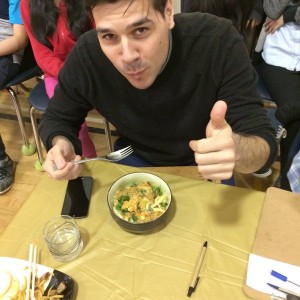The year at David Livingstone is drawing to a close. Students have been working hard over the last week, by writing thank you posters for local businesses who donated money for the trip to the Yukon. Over the last two decades, Ms. Cassie has worked really hard at building good relationships with local business. The Main Street corridor donates a lot of money towards the trips every year. It is nice to see that a good relationship goes a long way. Making sure to say thanks is important. Students create large posters and decorate them. A picture of all 54 students, who went on the trip, has been attached to the bottom of each poster to show the impact that the businesses’ contribution has on David Livingstone students. On Friday we go out an deliver them.
The year has really been amazing. I had always imagined that I would have a good time teaching but this process has taught me so much about myself. It really has been a journey, and I almost hate to say it but, I have changed. So much about this process, as far as I can tell, is about humility, co-operating, and working hard. Taking in so much feedback is a very difficult thing, especially when you are working so hard. The results, on the other hand, are undeniable. I really feel like I have grown into a “teacher”
Now, I suppose the anxiety begins. Will I get a job? I hope so. I really do love this profession. It is far more work than I thought it could be, but it is by far the most rewarding work I have ever participated in. Working with young people is just so amazing!
Now to reflect about the inquiry presentation at the Vancouver Public Library. Wow! What an event.
For about 5 hours divisions 1 and 2 filled the VPL’s promenade. At first there ways a little nervousness on my part; as I thought to myself “Will anyone talk to these kids?” Not only did many people take a genuine interest in the students project, lots of members of the public would stop and talk with a group for 30 minutes. IT HAPPENED CONSTANTLY! It was so great to see students genuinely engage with members of the public for so long. What a wonderful time.
I invited my 96 year old grandmother, who happens to be a retired teacher, to come down to the event. She took the handy-dart and arrived at around 11:00am. She made here way through every poster. She couldn’t believe how great the students were. That means something coming from a pro like her!
It was great to see the product of a year of work on display. You can really see the impact that a large field trip, and a yearly theme has on learning. The students REALLY knew what they were talking about.
————————————————————————————————————–
So know it is the last day and I am met with mixed emotions. On one hand I am thinking “yes! I am FINISHED” on the other hand I am sad that my time with the students has drawn to a close. Yesterday we went to the beach. It was a nice way to finish off the school year. Today we are cleaning. There is lots to do but the kids are pretty ambicious. They seem content to clean for hours. I have cleaned up my desk and have gathered my things. It seem odd to think that I will not be back in the classroom after sending so much time, and work, here. L
